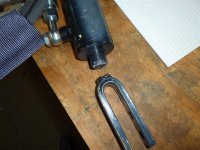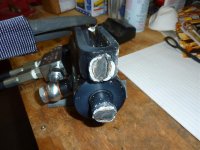Monster5601
Platinum Member
I am interested in hearing opinions on why this weld failed from the experienced welders. I hope the pictures have enough detail to allow a diagnose. If not, let me know and I can snap a few more pictures.
***EDIT***
Thanks for all the responses and advice. To answer a few question brought out in the thread:
This is a side link for a CAT 1 three point.
It had just a few hours of use before it failed using a Bush Hog 5 foot box blade.
It was fabricated state side by a hydraulic side link provider.
The clevis mounts at about a 14 degree angle to the ram.
No, I am not going to fix this, I will either return for refund or take to a local welding shop for repair.
What I am looking for now and from what I'm reading in the thread is this is fixable once the ram is ground to an angle so that there is 100% butt made between the clevis and the rod.
Thanks for all your input, I am not that knowledgeable on welding.
***EDIT***
Thanks for all the responses and advice. To answer a few question brought out in the thread:
This is a side link for a CAT 1 three point.
It had just a few hours of use before it failed using a Bush Hog 5 foot box blade.
It was fabricated state side by a hydraulic side link provider.
The clevis mounts at about a 14 degree angle to the ram.
No, I am not going to fix this, I will either return for refund or take to a local welding shop for repair.
What I am looking for now and from what I'm reading in the thread is this is fixable once the ram is ground to an angle so that there is 100% butt made between the clevis and the rod.
Thanks for all your input, I am not that knowledgeable on welding.
Attachments
Last edited:

